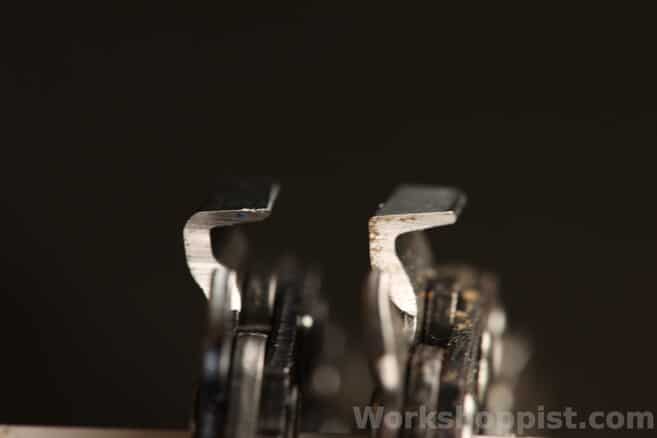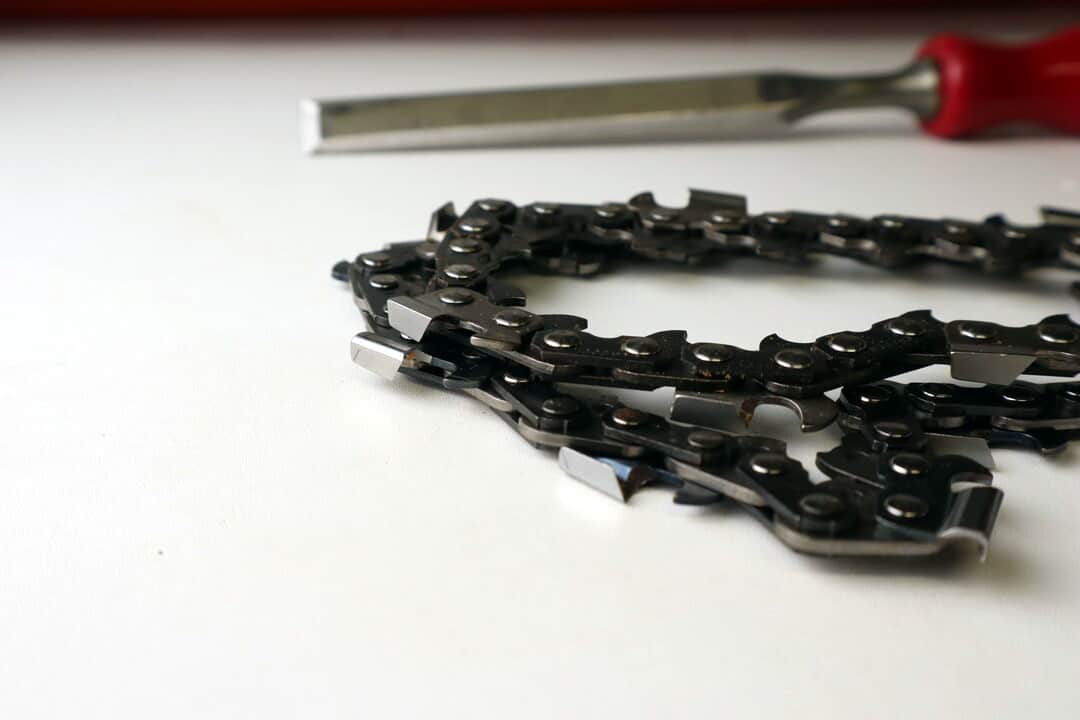The world of chainsaw chains is full of small differentiations: the four gauges and seven pitches, standard vs. low profile chains, narrow kerf vs. regular and skip tooth – plus a few proprietary terms like Picco and Pixel thrown into the mix. This array of choices can be pretty confusing, particularly for a beginner.
Today, we are going to look at yet one of these chainsaw chain variations: semi-chisel and full-chisel chains. What do these terms mean in chainsaw chains and which type of chain should you use? And do they have anything to do with chisels? In this article I will explain the difference between semi-chisel and full-chisel chains.
Summary: Semi-chisel chains have cutters with a slightly rounded shoulder, and offer a good balance between performance and ease of use and sharpening. Full-chisel chains, by contrast, have cutters with a sharp shoulder. They are more efficient and faster-cutting, but also dull faster, are harder to sharpen, and are more prone to kickback. Semi-chisel chains are the best choice for general use, while full-chisel chains are preferred in professional use for maximal productivity in softwood cross-cutting.
Next, we will start by taking a closer look at the semi- and full-chisel tooth/cutter profiles. Then I will tell you why the full-chisel chain cuts faster and continue into the other aspects: dulling, sharpening and kickback safety.
Semi vs. Full-chisel teeth
The below macro-photograph shows you the front view of semi- and full-chisel chain cutters side by side. In the closeup, the difference is obvious:
The semi-chisel cutter on the left has a rounded transition from the side plate to the top plate; the cutter has a round shoulder.
In the full-chisel cutter, by contrast, the side plate and the top plate meet in a sharp 90-degree corner – i.e. the cutter has a sharp shoulder.

Why does Full chisel cut faster?
So why is it that a chain with full-chisel cutters can cut faster than a semi-chisel chain? The explanation to this is simple but not entirely obvious:
A full-chisel chain is more efficient because the full-chisel cutters avoid re-cutting wood fibers that were already cut. Let us unpack this.
Semi-chisel must recut
To understand this, consider first the semi-chisel cutter: On each pass through wood, the entire rounded shoulder area of the cutter is doing heavy cross-cutting of wood fibers.
But because of the rounding, the top parts only do a partial-width cut. This forces the next cutters to recut the same fibers further out to widen the cut to full kerf. This recutting of wood fiber is double work, and lowers the semi-chisel chain efficiency.
Full-chisel does not
Now, consider the full-chisel chain: the sharp vertical shoulder means that each wood fiber is cut to full kerf on the first go – no recutting required. This gives the full-chisel chain higher cutting efficiency.
With the same saw engine output horsepowers, the higher efficiency of full-chisel chains translates directly to a faster cutting process.
No ripping advantage
Note that this discussion referred to cross-cuts, i.e. cuts across the wood grain, which cover probably 95% of chainsaw use cases. (If you’re not familiar with the terms cross-cut and ripping cut, please check my article on the topic.)
The situation is totally different in ripping cuts, which happen along the grain. As the cutting now happens into the grain, recutting is unavoidable – the whole cut basically consists of repeatedly cutting a bit off the ends of the very same wood fibers.
Because of this, full-chisel chains have no efficiency advantage in ripping cuts compared to semi-chisel chains. Although they could in principle have some other advantages, most ripping chains seem to employ a semi-chisel shoulder profile.
Full-chisel drawbacks
If full-chisel chains are more efficient, why isn’t everybody using them? The answer is that, compared to semi-chisel and round tooth chains, full-chisel chains have three significant downsides:
- they dull fast
- they are difficult to sharpen optimally
- they are more prone to kickback
These downsides make the full-chisel chain a bit trickier and less practical to use. Let us look at each of these in turn:
1 Dulling
The sharp shoulder of a full-chisel cutter is very heavily loaded, and a rather pointed protrusion compared to the better supported rounded forms of semi-chisel cutters.
The result is fast wear and dulling at the cutting edge: a full-chisel chain will lose its bite faster than a semi-chisel or rounded cutter chain. In practice, this means more sharpening breaks in the middle of sawing and eats some of the time gained in faster cutting.
2 Sharpening
Full-chisel chains deliver the best results when they are square ground. A square grind is a special cutting edge profile where the side and top plates both have constant sharpening angles all the way.
A square ground cutter is harder to sharpen than the conventional round grind: it requires more skill and time and special file or grinding wheel profiles.
A full-chisel chain can also have a round grind, allowing it to be sharpened as the typical semi-chisel chain, but this lowers the cutting speed.
3 Kickback
Full-chisel chains are more prone to kickback and therefore less safe than semi-chisel or round-cutter chains. The greater kickback tendency is caused simply by the full-chisel chain being a more aggressive cutter: more grip per tooth makes the recoil stronger.
For this reason most full-chisel chains do not comply with the ANSI B175.1 kickback standard and they are not recommended for inexperienced chainsaw users.
Pros & Cons
| Property | Semi-Chisel | Full-Chisel |
|---|---|---|
| Cutting speed: | – slower | + higher |
| Dulling: | – slower | + faster |
| Sharpening: | + easier | – more difficult |
| Kickback: | + milder | – stronger |
| Grind: | round | square, round |
Which to choose?
Semi-chisel chains are general-purpose chains and the best choice for typical cross-cutting, ripping, limbing and bucking and mixed use. They are easy to sharpen with the round files or grinding wheels you likely have at hand, and most are low-kickback approved, making them much safer.
Full-chisel chains are specialty chains best for fast cross-cutting of softwoods. Using a full-chisel chain makes sense when there is a premium on time-efficiency and you have the proper sharpening tools at hand. An example of such a task is cutting firewood.
Full-chisel chains do not give much benefit in ripping cuts or cutting in dirty conditions. They give no benefit at all unless sharpened more often than semi-chisel chains.
Conclusions
In this article, we learned the difference between semi-chisel and full-chisel chainsaw chains. We saw the cutter forms that make the difference and discussed the pros and cons that follow from it.
My personal conclusion is that full-chisel chains are for the experienced user or professional with the skills and the tools to maintain the square grind – semi-chisel is the way to go for everyone else.
